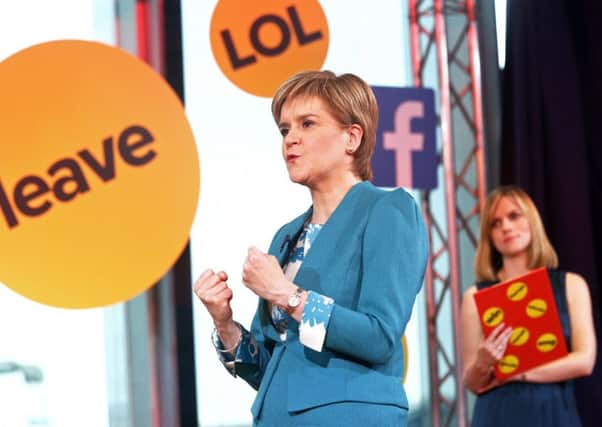Leaders: Sturgeon is caught in a cleft stick over Remain


With opinion polls showing UK voters almost evenly split on the EU referendum, the turnout and verdict of Scottish voters could hardly be more important. First Minister Nicola Sturgeon says Scots “can make the difference” and that the latest polls supporting Brexit should be “a wake-up call” to working class voters.
With just ten days to go to the poll, it is hard to imagine how much louder that “wake-up call” has to get for traditional Labour voters to rally behind ‘Remain’.
Advertisement
Hide AdAdvertisement
Hide AdFor weeks, the headlines have been dominated by warnings of what a vote to leave the EU will mean – from recession to a fall in household wealth and poorer pensions. Labour’s deputy Tom Watson and other senior party figures say a further £18 billion of spending cuts and tax rises would be in the pipeline should the UK leave the EU.
Meanwhile chancellor George Osborne has warned in a visit to the Borders that leaving the EU would cause a “profound economic shock” and wipe £4.5 billion from Scotland’s economy.
By the force of her conviction, Ms Sturgeon may well have more influence on working class voters to pay heed and vote Remain than the leaders of the Labour Party.
But the problems with this are threefold. First, it has to be asked why such a bombardment of dire warnings has not already put support for remaining in the EU so well ahead as to leave the June 23 vote in no doubt. Might it be that these warnings have lost credibility? Ms Sturgeon has been right to warn against the persistently negative scare tactic campaigning that the Remain camp has adopted.
But if the Labour Party big guns are having little impact in galvanising their supporters in Scotland to support Remain, what prospect is there that admonitions from the SNP leader will succeed? Labour leader Jeremy Corbyn’s speeches are lacklustre and widely held to reflect his own long-standing personal misgivings on our EU membership. In recent days it has become clear that many within Labour favour a vote to leave.
There are also indications within the SNP itself of support for Brexit.
All that said, there is little doubt that opinion in Scotland is generally more favourable to Remain. But the issue here is whether the strength of that opinion is sufficient to carry voters to the polls. Such ‘soft’ support may be of little help to Ms Sturgeon if it does not result in voter turnout, conceding an advantage to the more committed Leave supporters.
This might suggest that the First Minister steps up her Remain campaign. The danger here is that she falls into the David Cameron trap: by becoming the hardline front and centre of one side, her authority to speak on behalf of all of Scotland is compromised.
Advertisement
Hide AdAdvertisement
Hide AdOn the issue of a second Scottish referendum on independence, her wording reflects a politic circumspection given the notable lack of voter appetite for a further divisive constitutional battle. Care on the EU issue generally should be her guide.
Carnage seemingly without end
Just when we think we have seen the worst of what a lone, crazed, gunman can do comes another massacre that defies comprehension. The assault on a gay nightclub in Orlando, Florida, has left at least 50 dead, 53 injured, a city in a state of emergency and a nation stunned by the deadly ferocity of this outrage.
It is the worst mass shooting in recent US history, surpassing the 2007 massacre at Virginia Tech that left 32 people dead. It is tempting for Americans to view this as a singular and extraordinary outrage, a one-off assault exceptional on every measure.
But what lends greater horror to this carnage is that it is all too appallingly familiar. The Orlando gunman, named by police as Omar Mateen, might well have drawn on recent precedent. In 2012, Adam Lanza shot 27 people dead including six and seven year old children at Sandy Hook, Connecticut; in 1991, George Hennard killed 23 when he drove through the wall of a cafe in Killeen, Texas; in 2015, Syed Rizwan Farook and Tashfeen Malik killed 14 in San Bernardino; in 2009, Major Nidal Malik Hasan opened fire at an army base in Fort Hood, Texas, and killed 13.
The latest massacre follows attempts to curb this grisly carnage with tighter gun laws. These may have frustrated other would-be mass assassins but the outrages continue.
Police have described the latest massacre as an act of terrorism – the suspect was a US citizen of Afghan descent. In truth, all such massacres can be so described. Whether the latest killings were likely to be ideologically motivated must await a thorough enquiry.
For the moment we can only share the shock across America that one man can inflict such a toll of murder and mayhem.